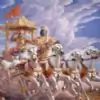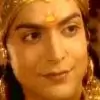For Those Who are Interested in Knowing the True Meera Bai Story from the History.Here's For You The History of Meera....Enjoy..& Do Leave Your Comments & Don't Forget To Hit the "LIKE" Button....
Summary
MiraBai (1498 - 1547) was a Rajput princess who lived in the north Indian state of Rajasthan. She was a devout follower of Lord Krishna. MiraBai was one of the foremost exponents of the Prema Bhakti (Divine Love) and an inspired poetess. She sang in vraja-bhasha, sometimes mixed with rajasthani, in praise of Giridhara Gopala (Shri Krishna), her lord for whom she developed in her heart the most intense love and devotion.
Detailed
Mirabai (c.1498-c.1547CE) (alternate orthographies: Meera; Mira; Meera Bai) was an aristocratic Hindu mystical singer and devotee of Rajasthan and one of the most significant figures of the Sant tradition of the Vaishnava bhakti movement. Some 12-1300 prayerful songs or bhajans attributed to her are popular throughout India and have been published in several translations world-wide. In the bhakti tradition, they are in passionate praise of Krishna.
Details of her life, which has been the subject of several films, are pieced together from her poetry and stories recounted by her community and are of debatable historical authenticity, particularly those that connect her with the later Tansen. On the other hand, the traditions that make her a disciple of Ravidas who disputed with Rupa Goswami are consonant with the usual account of her life.
==Biography
Meera, a Rajput princess was born in Kudki , a little village near Merta, which is presently in the Pali district of Rajasthan in northwest India. Her father, Ratan Singh, was a warrior of the Rathore clan, the son of Rao Jodha of Mandore (1416-1489 ), founder of the city of Jodhpur in 1459.
As an infant Meera became deeply enamoured of an iconic doll of Krishna owned by a visiting holy man.
Meera's marriage was arranged at an early age, traditionally to Prince Bhoj Raj, the eldest son of Rana Sanga of Chittorgarh. Her new family did not approve of her piety and devotion when she refused to worship their family deity and maintained that she was only truly married to Krishna.The Meera Museum in Merta City. The Rajputana had remained fiercely independent of the Delhi Sultanate the Islamic regime that otherwise ruled Hindustan after the conquests of Timur. But in the early 16th century the central Asian warlord Babur laid claim to the Sultanate and some Rajputs supported him while others ended their lives in battle with him. Her husband's death in battle (in 1527 ) was only one of a series of losses Meera experienced in her twenties, including the death of her parents. She appears to have despaired of loving anything temporal and turned to the eternal, transforming her grief into a passionate spiritual devotion that inspired in her countless songs drenched with pain and separation from her Krishna.
Meera's devotion to Krishna was at first a private thing but at some moment it overflowed into an ecstasy that led her to dance in the streets of the city. Her brother-in-law, the new ruler of Chittorgarh, was Vikramjit Singh, an ill-natured youth who strongly objected to Meera's fame, her mixing with commoners and carelessness of feminine modesty. There were several attempts to poison her. Her sister-in-law Udabai is said to have spread defamatory gossip.
At some time Meera declared herself a disciple of the guru ravidas . She considered herself to be a reborn gopi, Lalita, mad with love for Krishna. However the priest in charge of the temple of Mathura sometimes identified as Rupa Goswami, a disciple of Chaitanya is said to have refused allow Meera to enter the temple because she was a woman. Mirabai replied there was only one real man in Vrindavan, Krishna; everyone else was a gopi of Krishna. She continued her pilgrimage, "danced from one village to another village, almost covering the whole north of India" One story has her appearing in the company of Kabir in Kashi, once again causing affront to social mores. She appears to have spent her last years as a pilgrim in Dwarka inGujarat.
MiraBai was born in 1504 AD at Chaukari village in Merta District of Rajasthan. Merta was a small state in Marwar, Rajasthan ruled by the Ranthors, great devotees of Vishnu. Her father, Ratan Singh, was the second son of Rao Duda ji, a descendent of Rao Jodha ji Rathor, the founder of Jodhpur. MiraBai was raised and nurtured by her grandfather. As customary with royal families, her education included knowledge of scriptures, music, archery, fencing, horseback riding and driving chariots ' she was also trained to wield weapons in case of a war. However, MiraBai also grew up amidst an atmosphere of total Krishna consciousness, which was responsible in molding her life in the path of total devotion towards Lord Krishna.
When she was just four years of age, she manifested her deep devotion to Krishna. MiraBai watched a marriage procession in front of her residence. MiraBai, the child, spotted the well-dressed bridegroom and asked her mother innocently, "Dear mother, who will be my bridegroom?" MiraBai's mother smiled, and half in jest and half in earnest, pointed towards the image of Sri Krishna and said, "My dear Mira, Lord Krishna - this beautiful fellow ' is going to be your bridegroom". Soon after, MiraBai's mother passed on. As MiraBai grew up, her desire to be with her Krishna grew intensely and she believed that Lord Krishna would come to marry her. In due course, she became firmly convinced that Krishna was to be her husband.
MiraBai was soft-spoken, mild-mannered, gifted, sweet, and sang with a melodious voice. She was reputed to be one of the most extraordinary beauties of her time with fame spreading to several kingdoms and provinces. Her fame spread far and wide. Rana Sangram Singh, commonly known as Rana Sangha, the powerful King of Mewar, approached Rao Duda for MiraBai's hand in marriage to his son Bhojraj (also known as Rana Kumbha or KumbhaRana). Bhojraj wanted to marry MiraBai for her pious nature and divine intent. Rao Duda agreed to the union. However, MiraBai could not bear the thought of marrying a human being when her heart was filled with thoughts of every nature, all about her Krishna. But unable to go against her beloved grandfathers word, she finally consented to the marriage. MiraBai was wed to Rana Kumbha in 1513, before she turned 14. As ordained, MiraBai was dutiful. She left for (Chittorgarh) Mewar with the Rana Kumbha.
After her household duties were over, Meera would go to the temple of Lord Krishna, worship, sing and dance before Lord Krishna Idol daily. KumbhaRana's mother and other ladies of the palace did not like the ways of MiraBai, as they were worldly-minded and jealous. MiraBai's mother-in-law forced her to worship Durga and admonished her often. But MiraBai maintained, "I have already given up my life to my beloved Lord Krishna". MiraBai's sister-in-law Udabai formed a conspiracy and began to defame the innocent Meera. She informed Rana Kumbha that Meera was in secret love with some one, that she witnessed Meera talking to her lover(s) in the temple, and that she would show him the persons if he would accompany her one night. The ladies further raved that MiraBai, by her conduct, had brought a great slur on the reputation of the Rana family of Chittor. The enraged Kumbha ran with sword in hand towards Meera, but as luck would have it Meera had gone to her Krishna temple. A sober relative of the Rana counseled him, "Rana! You will forever repent for your hasty behavior and consequences. Enquire into the allegation carefully and you will find the truth. Meera bai is a great devotee of the Lord. Remember why you sought her hand. Out of sheer jealousy the ladies might have concocted scandals against Meera Bai to incite you and ruin her". Kumbha calmed down and accompanied his sister who persistently took him to the temple at dead of night. Rana Kumbha broke open the door, rushed inside and found Meera alone in her ecstatic mood talking and singing to the idol.
The Rana shouted at Meera, "Meera, show me your lover with whom you are talking now". Meera replied, "There sits He'my Lord'the Nanichora who has stolen my heart". She went into a trance. The ladies floated other rumors that Meera was mixing very freely with Sadhus. Meera was unaffected by such scandals and continued to invite Bhagavathas to join her in Krishna bhajan at the temple. She stood unruffled in the face of accusations from the royal family. When questioned about her marital responsibilities, Meera responded that it was Krishna to whom she was married. KumbhaRana was heart-broken but remained a good husband and sympathizer of Meera until his death.
Rana's relatives began persecuting Meera in various ways, even though Meera had no desire for the throne. Meera was sent a basket with a cobra inside and a message that the basket contained a garland of flowers. Meera, after meditation, opened the basket and found inside a lovely idol of Sri Krishna with a garland of flowers. The relentless Rana (her brother-in-law) sent her a cup of poison with the message that it was nectar. Meera offered it to her Lord Krishna and took it as His Prasad. It was real nectar to her. The bed of nails that the Rana sent transformed into a bed of roses when Meera reposed on it.
When the torture and scandals continued, Meera sent a letter to Goswami Tulsidas and asked for his advice. She wrote, "Simply because I am constantly tortured by my relatives, I cannot abandon my Krishna. I am unable to carry on with my devotional practices in the palace. I have made Giridhar Gopala my friend from my very childhood. I feel a total bondage with him. I cannot break that bond".
The turning point in Meerabai's life occurred when once Akbar and his court musician Tansen came in disguise to Chittor to hear Meera's devotional and inspiring songs. Both entered the temple and listened to Meera's soul - stirring songs to their heart's content. Before he departed, he touched the holy feet of Meera and placed a necklace of priceless gems in front of the idol as a present. Somehow the news reached the KumbhaRana that Akbar had entered the sacred temple in disguise, touched the feet of Meerabai and even presented her a necklace. The Rana became furious. He told Meerabai, "Drown yourself in the river and never show your face to the world in future. You have brought great disgrace on my family".
Meerabai obeyed the words of King. She proceeded to the river to drown herself. The names of the Lord "Govinda, Giridhari, Gopala" were always on her lips. She sang and danced in ecstasy on her way to the river. When she raised her feet from the ground, a hand from behind grasped her and embraced her. She turned behind and saw her beloved Giridhari. She fainted on him. After a few minutes she opened her eyes. Lord Krishna smiled and gently whispered: "My dear Meera, your life with your mortal relatives is over now. You are absolutely free. Be cheerful. You are and have always been mine."
Meera walked barefoot on the hot sandy beds of Rajasthan. On her way, many ladies, children and devotees received her with great hospitality. She reached Brindavan (or Vrindaban). It was at Brindavan that she again met and was inspired by Sant Raidas. She went about Brindavan doing Oonchavritti and worshipped in the Govinda Mandir which has since become famous and is now a great place of pilgrimage for devotees from all over the world.
A repentant Kumbha came to Vrindavan to see Meera and prayed that he may be forgiven for all his previous wrongs and cruel deeds. He begged that Meera return to the kingdom and was assume her role as the queen once more. Meera said to Rana that Krishna is only one King and my life belongs to him. The KumbhaRana, for the first time, truly understood Meera's exalted state of mind and prostrated before her in reverence. He then promptly left Vrindavan a changed soul.
Jiva Gosain was the head of the Vaishnavites in Brindavan. Meera wanted to have Darshan of Jiva Gosain. He declined to see her. He sent word to Meera that he would not allow any woman in his presence. Mirabai retorted: "Everybody in Brindavan is a woman. Only Giridhar Gopala is Purusha. Today only I have come to know that there is another Purusha besides Krishna in Brindavan". Jiva Gosain was put to shame. He at once went to see Meera and paid her due respects.
Meera's fame spread far and wide. She was immersed in satsang day in and out. At the request of KumbhaRana, Meera returned to Mewar and Kumbha agreed to her request that she would reside in the temple of Krishna but would not restrict her movements and wanderings. From Mewar, she once again returned to Brindavan, and then went on to Dwaraka. The King went with her.
On Krishna's Janmashtami at the temple of Krishna. There was much happiness all around in the abode of the Lord. The light of the lamps, the sound of the bhajans and the energy from the devotees' ecstacy were filling the air. With Tamburi in one hand and cymbals or chipla in the other the great tapasvini was singing ecstatically with her Gopala smiling in front of her closed eyes. Meera stood up and danced with her song 'Mere Janama Maran ke sathee', and when the song ended, Kumbha gently approached her and requested her to come back. Meera said, 'Ranaji, the body is yours and you are a great devotee, but my mind, emotions and the soul are all his. I do not know what use am I to you at this state of mind'. Kumbha was moved and he started singing with her in unison. Meera rose up abruptly, stumbled and fell at the flowers on the feet of Giridhari. 'Oh, Giridhari, are you calling me, I am coming'. When Kumbha and the rest were watching in awe, there was a lightning which enveloped Meera and the sanctum doors closed on their own. When the doors opened again, Meera's saree was enveloping Lord Krishna's idol and her voice and the flute accompaniment were the only sounds that could be heard.
So many princesses and queens have come and gone. So many princesses, and queens have appeared on the stage of this world and vanished. How is it that the queen of Chittor alone is still remembered? Is this on account of her beauty? Is this on account of her poetic skill? No. It is on account of her renunciation, single-minded devotion to Lord Krishna and the self-realization. She conversed with Krishna. She ate with Krishna, her Beloved. She drank the Krishna-premarasa. She sang from the core of her heart about her unique spiritual experiences. She was indeed one of the foremost embodiments of Premabhakthi that ever walked on earth.
------------------------------------------------------------------------------------------------
Updated By : khushi:-)
Meera Bai (1498 - 1547) was a devout follower of Lord Krishna. Meera Bai was one of the foremost exponents of the Prema Bhakti (Divine Love) and an inspired poetess.
The story of Meera Bai is not based on historical documents but comes from oral storytelling. Each storyteller embellishes or distorts the story, or puts a different interpretation on it as time passes.
Based on these stories there are many places which are related to Meera Bai. This page is an effort to collect information about few of those places. Any feedback on this pages information is most welcome.
- Merta - Charbhuja Ji Temple
- Chittorgarh - Fort Of Chittorgarh - Kumbha Palace
- Chittorgarh - Kumbha Shyam Temple (Meera Mandir)
- Vrindaban - Banke Bihari Temple (Meera Bai Temple)
- Dwarka - Jagat Temple (Temple Of Dwarkadheesh)
- Nurpur - Brij Raj Bihari Temple
- Amer Jaipur - Jagat Siromani Ji Temple
- Dakor - Ranchhodraiji Temple
1. Merta - Charbhuja Ji Temple
Merta is a small town in the Nagaur district, Rajasthan. Meera Bai was born as a daughter of Ratan Singh, grand-daughter of Merta's Rao Duda; and great-granddaughter of Rao Jodha, founder of Jodhpur.
Meera's mother died when the girl was 10 and the princess went to live with grandfather, Rao Duda, at Merta.
Charbhuja Temple in Merta is the Temple where Meera Bai worshipped Lord Krishna before her marriage to Prince Bhoj of Chittor.
The 400 year old Temple is also known as Meera Temple of Merta.

2. Chittorgarh - Fort Of Chittorgarh - Kumbha Palace
In 1516 Crown Prince Bhoj, son of Maharana Sangram Singh-I married the princess Meera Bai of Merta. The 'Kanwar Pada Palace' inside 'Kumbha Palace' was the place where Meera Bai used to live in Chittorgarh Fort.
Bappa Rawal built this palace which was later modified by Maharana Kumbah. This palace also has importance because of the site where Rani Padmini and thousands of the forts women and children committed JAUHAR.
Kanwar Pada Palace, Chittorgarh Fort
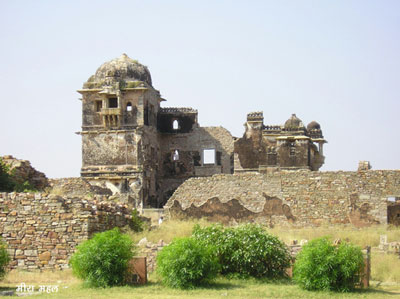
3. Chittorgarh - Kumbha Shyam Temple (Meera Mandir)
Maharana Kumbha build a Lord Vishnu Temple (Kumbh Temple) in 1449.
When Meera came to Chittor, she requested a small Krishna Temple for her personal use. Her father-in-law (Maharana SANGRAM SINGH I) built a small Temple adjoining Kumbh Temple, which was named as Kumbh (Kumbha) Shyam Temple. There she continued her devotions to Lord Krishna, and used her wealth to help feed religious pilgrims and the needy.
There is a small Chhatri in the Temple built in memory of Meera's saintly guru, Rai Das (Swami Ravidas) of Varanasi. The saint's footprints are marked on the floor of this small shrine.
Kumbha Shyam Temple, Chittorgarh Fort
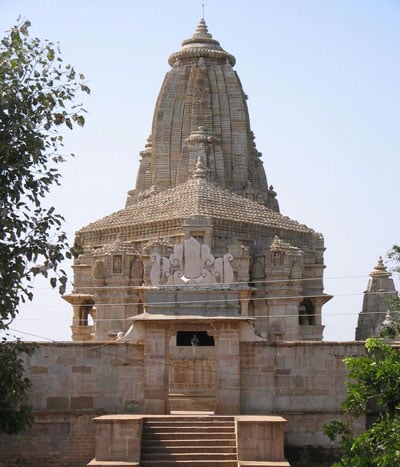
4. Vrindaban - Banke Bihari Temple (Meera Bai Temple)
The holy land of Vrindavan is situated 12 km north west of Mathura, UP. Vrindavan lies in the heart of the region called Brij. It is the place where Sri Radha & Krishna had performed their Leelas, eons ago.
Around 1532, Meera Bai left Chittorgarh and moved to Vrindavan. After spending some years in Vrindavan, she went to Dwaraka and spent the rest of her life there.
A place has been identified where Meera Bai stayed in Vrindavan. As of now we do not have much information of pictures of this place.
Vrindavan also has a Meera Bai Temple.
5. Dwarka - Jagat Temple (Temple Of Dwarkadheesh)
Dwarka is holy town in Gujarat around 800 km south west of Chittor.
Meera Bai lived the final years of her life in Dwarka and there wrote to Krishna her immortal poems of love. Meera have infused Jagatmandir in Dwarka with a power of love.
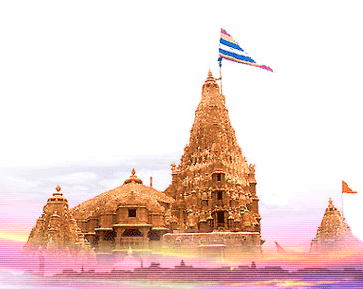
Dwarkadheesh Temple, Dwarka
6. Nurpur - Brij Raj Bihari Temple
Located around 66 Km from Dharamsala in Himachal Pradesh, Nurpur Fort was constructed by Maharaja Basu in the 16th century. One of the Krishna idol (build with black stone) prayed by Meera Bai was taken to Nurpur by Nurpur king Raja Basu (1580-1613). Raja Basu build a beautiful Temple for this Idol which is known as Brij Raj Bihari Temple.
The Krishna Temple is now ruined along with the fort but still has some carved relief work on stone. This antique idol of Lord Krishna is still preserved in Brij Raj Temple and worshipped by pilgrims. The lifelike idol of Lord Krishna playing his flute is matchless in its beauty.
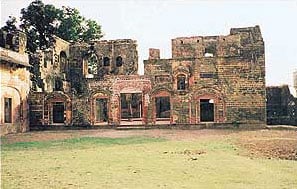
Nurpur Fort
7. Amer Jaipur - Jagat Siromani Ji Temple
Raja Man Singh I build an exquisitely carved marble-and-sandstone Lord Krishna Temple in Amer (Near Jaipur) in memory of his son. The Temple is well known as Jagat Shiromani Temple of Amer.
The Krishna idol which is placed in Jagat Shiromani Temple was one of the idols worshipped by Meera Bai.

Jagat Siromani Temple, Amer Jaipur
8. Dakor - Ranchhodraiji Temple
Dakor is located around 94 Km from Ahmedabad, Gujrat. Dakor is famous for Ranchhodraji Temple (A Lord Krishna Temple).
According to historical books, Chaitanya Mahaprabhu and Meera visited Dakor.
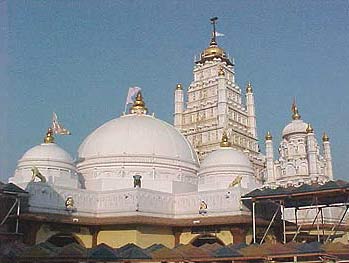
Ranchhodraiji Temple, Dakor
Meera is known for many beautiful bhajans that she sung in praise of lord Krishna. Few of the famous bhajan lyrics are as below: |
| Aisi Lagi Lagan, Meera Ho Gai Magan ... |
| Paayoji Maine Shyaam Ratan Dhan Paayo ... |
| Jo Tum Chhoodo Piya, Main Nahi Chhodu re ... |
| Barasai Badariyaa Saavan Kii ... |
| Herii Mhaa Darad DivaaNaa |
Meera Mahotsav (Mira Mahotsav)
Meera Smrithi Sansathan (Meera Memorial Trust) along with the Chittorgarh district officials organise Meera Mahotsav every year on Sharad Purnima day (On Mirabai's birth anniversary) for 3 days.
Many famous musicians and singers get together to sing bhajan's in this celebration. The 3 days celebration also features puja's, discussions, dances, fire works etc.
Do Leave Your Comments & Suggestions.
😊 Don't Forget To Hit the "LIKE" Button if You Liked the Post.. 😊










